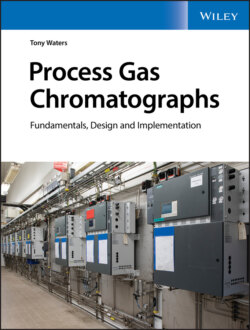Читать книгу Process Gas Chromatographs - Tony Waters - Страница 59
Limitations
ОглавлениеThe theory assumes that the distribution constant will remain constant. It is assumed, for example, that the distribution of propane molecules at equilibrium is constant regardless of the number of propane molecules present, and that the distribution is unaffected by the presence of other solute molecules in the stationary phase.
While generally true at the low concentrations of solute normally reached in a liquid phase as a peak passes through, either of these assumptions may fail at higher concentrations.
The first assumption is that the distribution is constant for varying amounts of solute. At low concentrations of solute in the liquid phase, the distribution constant is indeed constant for most solute‐solvent pairs. But high concentrations of solute may exceed the linear range of Henry's Law, causing a large peak to become wider and distorted in shape.
The second assumption is that solute molecules are at such low concentration in the liquid phase that they do not interact with each other; i.e., the presence of one kind of molecule dissolved in the liquid phase will not affect the solubility of another kind of molecule.
This independence of solubility is generally found to be true in practice. A rapidly moving peak will pass right through a slower one, usually with no effect on the retention time of either of them. Even so, you should be aware that a very large peak can saturate the liquid phase and displace a low‐concentration peak from solution, thereby reducing the distribution constant and the retention time of the smaller peak.
